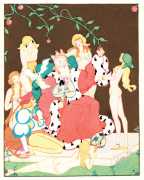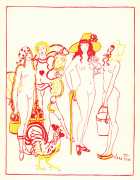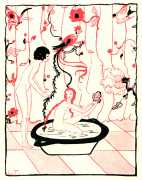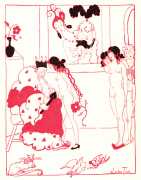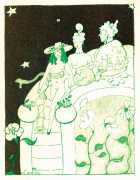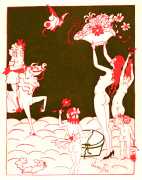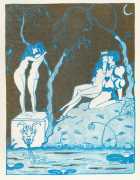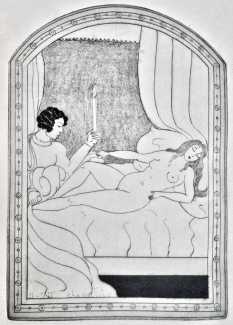
In 1925 Clara Tice’s work came to the attention of T.R. ‘Tommy’ Smith, then editor at the New York publishing house Boni & Liveright. Smith immediately commissioned her to illustrate the Arthur Machen translation of One Hundred Merry and Delightsome Tales, a project that was followed by Boccaccio’s Decameron, and a series of books for the Pierre Loüys Society.
The French writer Pierre Loüys already had a following in the United States for his ribald tales, and Tice’s illustrations proved an ideal accompaniment to his texts. This presented her with an artist’s dream opportunity – no expense was spared on handmade paper, fine typography, and de luxe bindings. She was instructed to disregard reproduction costs, so plates were often produced in a wide range of colours, including silver and gold.
In spite of their quality, Tice’s illustrations were seen as prurient and bordering on the pornographic. The writer Henry Louis Mencken recalled frequent visits to Tice’s editor, his friend and a constant companion throughout the 1920s. Tommy Smith was notorious for his collection of pornography, and Mencken recalled that its ‘pearl’ was a portfolio of original drawings by Clara Tice, which Smith enjoyed showing off to impress and titillate his female guests.

The first of Boni & Liveright’s Pierre Loüys Society volumes was The Adventures of King Pausole, Loüys’ most-often-illustrated work. The Clara Tice frontispiece is printed in seven colours, including metallic gold, while the other illustrations demonstrate highly imaginative and experimental colour combinations. Nine hundred and ninety numbered copies were printed.
This English translation of King Pausole, by an unknown translator who also supplied a witty Translator’s Preface, is the best of several which have been attempted, successfully capturing Loüys’ engaging style.


